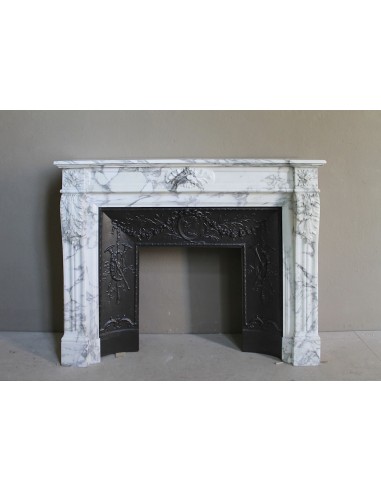Classic and faultless Louis XVI “Trois Fleurs,” the most beloved fireplace of the wealthy bourgeoisie of the Antique Napoleon III period, a nineteenth-century fireplace model that even today is the recordman of preferences among the most ‘trendy’ (or “trendy,” or who knows how it will ever be spelled, I, with English, just don't have a feeling...) interior decorators and wives.
But... they are not all alike, the Trois Fleurs, maybe they look alike to the layman, and very similar to each other they are, otherwise they could not have in common that pretty and floral nickname of theirs but, I repeat, THERE IS NOT ONE IDENTICAL TO THE OTHER. EACH SCULPTOR OR EACH FURNITURE “MAISON” HAD ITS OWN AND SPECIFIC “MODEL,” AS IS ONLY FAIR BECAUSE EACH SEEKS ITS OWN PERSONALITY.
This “piece” that I am presenting to you today has sculptural figures very much in relief, so much so that you feel like touching them, those acanthus leaves on the shoulders that seem to be coming toward you, escaping the marble that has been holding them to itself for more than a century and a half..
Of course, as befits the most important mantels, our Trois Fleurs also has its sides decorated with appropriately neoclassical fluting.
Our mantel is at the highest level in the realm of stylism (Parisian) and sculptural load (Pietrasantino), but, in spite of all this beauty and quality, yes it is also embellished with a marble fabric also at the pinnacle of the refined preferences of the architects of the Antique, A FANTASTIC AS NOBLE STATUARY ARABESCATO MARBLE!!!
But its refinements are not over, let us look together at its cast iron insert.... That refined OVAL encloses the face of a beautiful woman, and this decoration is the element that gives its name to the family of the cast iron insert itself, which is thus named TETE DE FEMME". But even here the designer was not content with this famous decoration, but chose for the “legs” of the cast iron insert itself two castings each depicting a pair of upward-facing trumpets.. This decoration is called“Instruments de musique”,its birth dates back to the Louis XVI period (second half of the eighteenth century) but rinaque and found much success in the Napoleon III period (Second half of the nineteenth century).
EXCELLENT CONDITION AND PATINA, PARISIAN FIND.
















































































